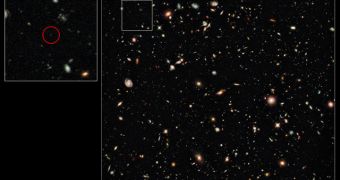Using an advanced telescope, experts were able to determine the most distant point in the sky, which is apparently located no less than 13.1 billion light-years away from Earth.
This basically means that this galaxy formed about 650 million years after the Big Bang exploded the Universe into being, even before the reionization epoch concluded, some 1.1 billion years after the Cosmos inflated.
According to the new investigation, the galaxy UDFy-38135539 contains roughly 1 billion stars, give or take, and it was undeniably one of the first such cosmic structures ever to develop.
The new study basically confirms that the galaxy is there, since the formation was discovered for the first time back in 2009, when experts used NASA Hubble Space Telescope to peer deeper into the sky than ever before.
Using the European Southern Observatory's (ESO) Very Large Telescope (VLT), in Chile, experts at the Paris Observatory in France were able to confirm the existence of UDFy-38135539 in a series of observations that spanned 16 hours.
The way this was done was by measuring the distortion caused by the expansion of the Universe on the faint glow that the old galaxy produced.
The previous record-holder in terms of distance was a cosmic phenomenon called a gamma-ray burst (GRB), which is one of the most violent events that can take place in the Cosmos.
This particular galaxy is about 100 million light-years further than the GRB source, so this makes it officially the most distant known object in the Universe, Space reports.
One thing that puzzled the research team was that the structure developed so well within the reionization epoch, which was characterized by intense ultraviolet radiation bombardments originating from supermassive black holes called quasars.
“One of the most dramatic impacts galaxies have had on the whole history of the Universe is through reionization,” explains PO astronomer Matthew Lehnert, who was the lead author of the new study.
Details of the investigation appear in the October 21 issue of the esteemed scientific journal Nature.
“This is the first time we know for sure that we are looking at one of the galaxies that cleared out the fog which had filled the very early universe,” explains University of Paris-Sud in France astronomer and study coauthor Nicole Nesvadba.
The new observations were made possible by the incredible capabilities of the VLT, which is a telescope array featuring 4 primary mirrors and 4 secondary ones. It works via interferometry.
“This is just the type of science that will be routine when ESO's European Extremely Large Telescope – which will be the biggest optical and near infrared telescope in the world – becomes operational,” says Jean-Gabriel Cuby.
The expert, who was also a coauthor of the new research paper, holds an appointment at the Laboratory of Astrophysics of Marseille, in France.
ESO, which is the most prolific astronomical organization in the world, has finally decided to build its newest instrument, the European Extremely Large optical/infrared Telescope (E-ELT), at Cerro Armazones, in Chile.
The massive construction's main feature will be a whooping 42-meter-diameter primary mirror, which will ensure unprecedented observations power, even for a ground-based observatory.
Once completed, the E-ELT will be the most massive instrument of its kind, and the “world's biggest eye on the sky,” according to European officials.

 14 DAY TRIAL //
14 DAY TRIAL //